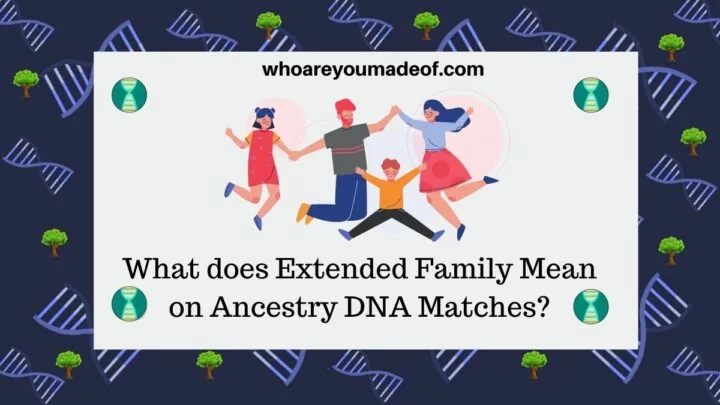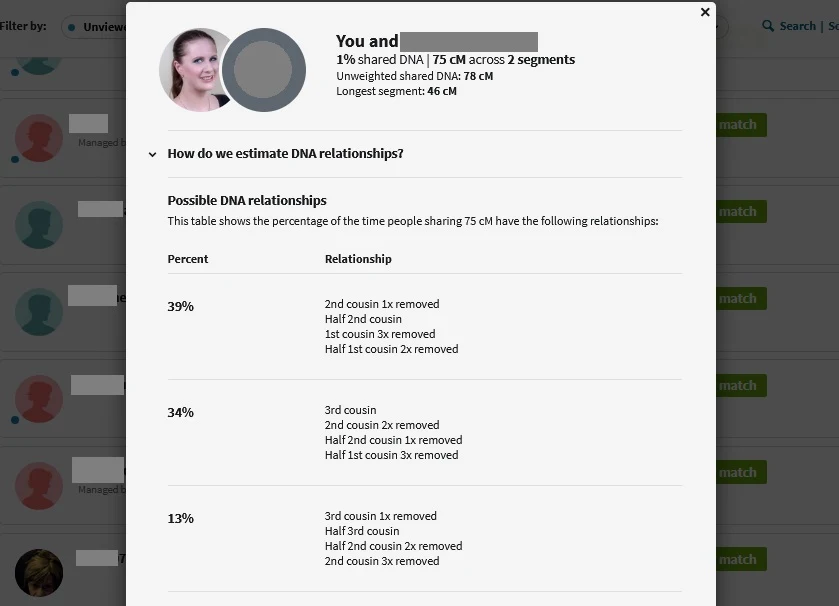Have you seen relatives in the Extended Family match category on Ancestry DNA? In this post, learn how these individuals might be related to you.
If you did a DNA test with Ancestry, you have probably noticed that you have quite an extensive list of DNA relatives, or DNA matches, as they are called on the site. These are people who share DNA with you and are likely related to you in some way.

Ancestry DNA organizes your DNA matches into groups based on how much DNA they share with you. Some of your DNA matches are more closely related than others.
As you might have guessed, the Extended Family category on Ancestry includes relatives who are not immediate family. However, extended family doesn't really mean "distant" family, either - right?
Even though some matches are closely related and others are more distantly related, you are most likely related in some way to most of your DNA matches. If you knew the names of all of your ancestors, and your DNA matches did, too, you would be able to find names in common among those ancestors.
Below, I will explain how your DNA matches are grouped into the extended family category on Ancestry DNA. Plus, I will share some tips about whether it is possible to learn how you are connected to these relatives.
What are extended relatives on Ancestry DNA?
The Extended Relatives category of matches includes other Ancestry DNA customers who share between about 75-200 centimorgans (cMs) with you and definitely share a genealogical connection with you. While they are not immediate or close family members, they are not distant relatives, either.
That's why they are called "Extended Family"; they are members of your broader extended family. They might even be the children or grandchildren of older relatives that you met at family gatherings while growing up.

The image above is from my own DNA match list. The very first person in the Extended Family category is someone whose last name I recognize, though I have never met him.
However, I do remember meeting his grandmother, the younger sister of my great-grandmother, at a family member's funeral. Since our most recent common ancestors are my great-great grandparents (and his great-great grandparents), we are second cousins once-removed.
Many people grow up knowing at least some of their second cousins, since they are children of your parents' first cousins. However, we may not feel as close to these cousins as we do to our closer relatives, and so "extended family" is a good term to describe these family members.
As you have now noticed, since our Extended Family DNA matches are not distantly related, we might be able to learn about from them about our recent ancestors and other aspects of our family tree. Indeed, researching these DNA matches can be very helpful for genealogy research.
Which relatives might be in the extended family DNA match category on Ancestry?
Since we can share between about 75-200 cMs (1-2.7%) of out total DNA with our Extended Family Matches, we can be related to them in a variety of ways. The most recent common ancestor shared between us and our extended family matches can be as recent as a grandparent and as distantly as a great-great-great grandparent.
Some of the relationship possibilities we might expect to see between relatives sharing this amount of DNA are:
- First cousin three times-removed
- Half-great aunt/uncle
- Half-second cousin
- Third cousin
For a complete list of the potential relationship possibilities that you and your match might share, you can click on the blue link that shows how much DNA you share and see a list of potential relationships (and probabilities of each relationship) tailored to your individual DNA match.
How do you see this list? In the image below, you can see the red arrow points to where it says "75 cM | 1% Shared DNA" - that's where you should click:

Then, a screen will pop-up and you will be able to see much more information about your DNA connection to your extended family member, including the list of the ways you might be related:

From the image above, you can see that my cousin and I, sharing about 75 centimorgans of DNA with each other, are most likely to share one of the relationships from the first two categories. As I mentioned earlier in this article, I already know that this match is a second cousin once-removed, which fits perfectly into what Ancestry DNA tells me is one of our most likely relationship.
As you can see, there is quite an extensive list of potential relationships. This can make figuring out how you are connected to other extended family members more confusing.
You shouldn't worry, though, since I have some suggestions that might help you determine how you are related to your extended family matches.
How is your Extended Family DNA match related to you?
By learning as much as you can about your extended family DNA match's family tree and more details about your shared DNA relationship, you might be able to narrow down how they are related to you. Details such as the size of the longest segment you share, who your shared matches are, as well as comparing your family trees, can help you accomplish this.
For more detailed suggestions and examples about how to figure out how your DNA matches are related to you, whether they are close relatives or very distant cousins, you can read the following article:
Conclusion
I hope that this post has helped you learn everything that you wanted to know about the Extended Family DNA match category on Ancestry, and that you feel confident going forward trying to figure out how these DNA matches are related to you.
As always, if you have any questions about something that you read in this post, or if you would like to ask a question about how one of your Extended Family matches might be connected, please join us in the discussion below.
Thanks for reading today!


Margie Eastwood
Monday 10th of January 2022
This article was very informative.
Myself, my aunt and a DNA match are trying to figure out the DNA common ancestor. We are related through my maternal and her paternal side of the family. However; the DNA match person does not know who her father was so she can't complete any information on her tree on her paternal side. She would really like to find her father and we are trying to help her. What suggestions do you have to help us narrow down our search? She shares 252 cM | 4% shared DNA with my aunt.
Thanks
Margie